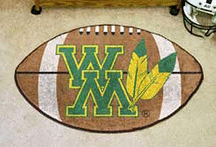William and Mary vs. NCAA

This post is long overdue and for that I apologize but I believe it is still interesting. The NCAA ruled over a month ago that the College of William and Mary could keep their nickname, Tribe, but had to abandon their logo which is two feathers. [The picture is a mat for wiping one's feet on which is only slightly better than the UFlorida seat cushions upon which one can plunk his derriere on Chief Osceola's face for ultimate comfort during football games.]
I found the NCAA decision to be quite fair. They took a pretty liberal stance on the use of Tribe as a nickname which school officials defend as "reflect[ing] our community's sense of shared commitment and common purpose." [from President Gene R. Nichol's October 10 letter to the WM community]
I am not an expert in Native American history in the state of Virginia and specifically with W&M but I am guessing "community" was not always an inclusive term. And "common purpose"? Both the commonness and the purpose are worthy of some scrutiny from an historical perspective. But the NCAA chose to review its present-day connotation and deemed it not hostile.
Not so the two feathers. This aspect of the decision did not go over well with the W&M powers-that-be. [I could make a pun here about ruffled feathers but because the story is so old, it's been done and I don't want to appear hackneyed.]
Nichol's letter is a two-page diatribe about why the NCAA is wrong about the two feathers being "hostile and abusive" (NCAA's words) and also why the school, despite its strong convictions that the feathers do no harm, will not appeal pursue legal action (the only option left to them because they already appealed the NCAA's initial decision against the feathers). The letter is a fairly self-righteous take on the school's and athletic department's policies and a condemnation of those of the NCAA. [I am not going to reprint the letter in its entirety but I am happy to send a copy to anyone who is interested.]
Here are some excerpts:
I am compelled to say, at the outset, how powerfully ironic it is for The College of William & Mary to face sanction for athletic transgression at the hands of the NCAA. [...] It is galling that a university with such a consistent and compelling record of doing things the right way is threatened with punishment by an organization whose house, simply put, is not in order.
I am one of the first to criticize the NCAA's leadership, policies, and procedures. But here we have the proverbial pot calling the kettle black scenario. W&M is not as pure and holy as the letter (which mostly cites high academic standards and graduation rates) lets on. Remember those are two feathers on their logo--not a halo. So how "compelling" is W&M's record--perhaps in regard to Title IX?
I was pointed towards some interesting research which found that as of the 2004-05 season W&M was within 6% of substantial proportionality. This is pretty good. But the numbers show that before they achieved this mark, W&M added 100 opportunities for their male athletes (in the late 1990s). This was impossible to sustain and their current proportionality is a result of cutting almost all of those spots throughout the past few years.
I find this, to use Nichol's word, "ironic" given that letter takes a (again, self-righteous) martyr-like tone when Nichol states that he has chosen not to pursue legal action because of the cost to the entire university. It seems that sustaining the Tribe athletic "community" financially was not as successful, especially if you were one of the 100 male athletes who became victim to the university's faulty economic model.
But because Title IX is not just about participation opportunities I will throw a few more of W&M's numbers (as of 2004-05) out there for your consideration: Female (team--they could be either male or female) head coaches receive, on average, approximately $24,000 less than male (team) head coaches. Women's teams received only 38 percent of the total coaching budget. They also received about 38 percent of the recruiting budget.
I am happy that W&M stresses academic excellence among its student-athletes, in spite of lax NCAA standards. But high graduation rates do not provide freedom from sanctions when an institution uses offensive (and often historically inaccurate) cultural appropriations of Native American imagery.
Comments